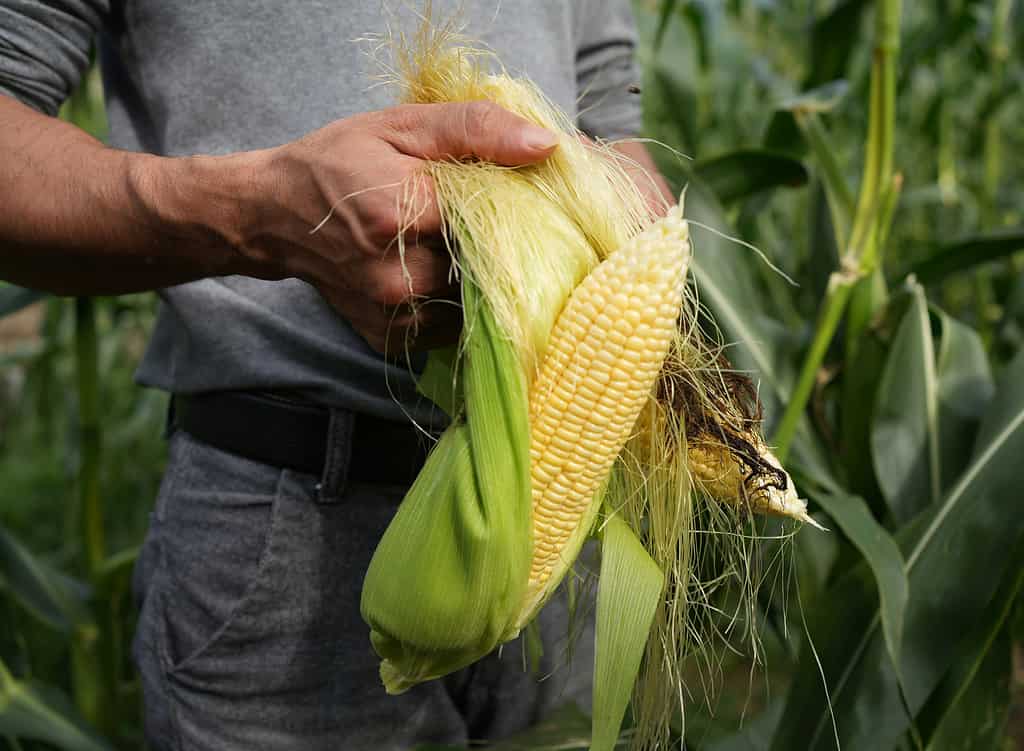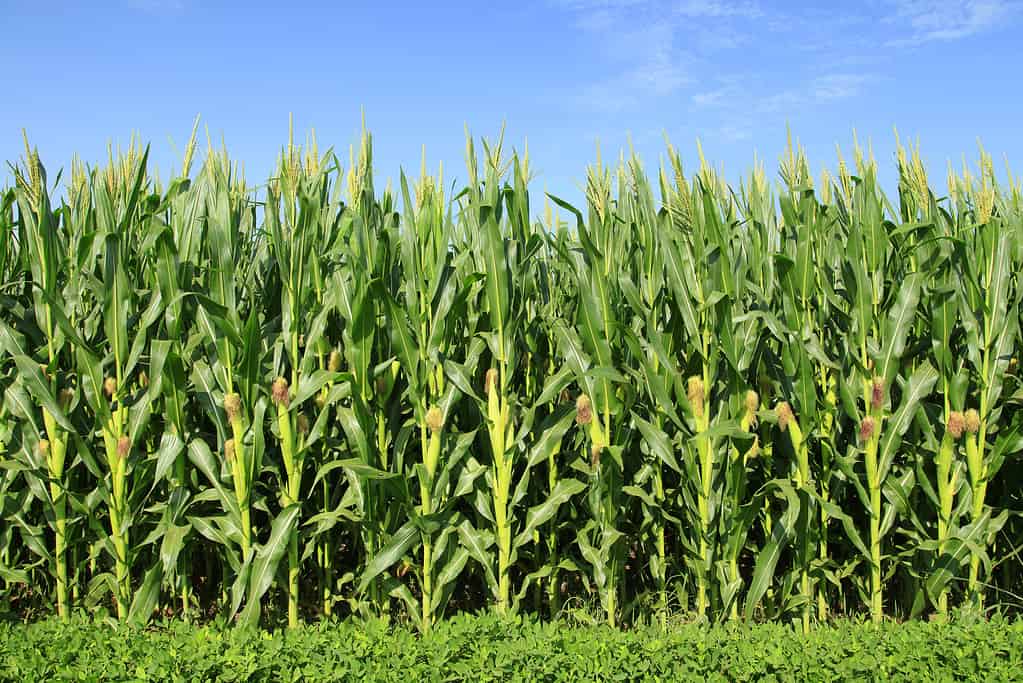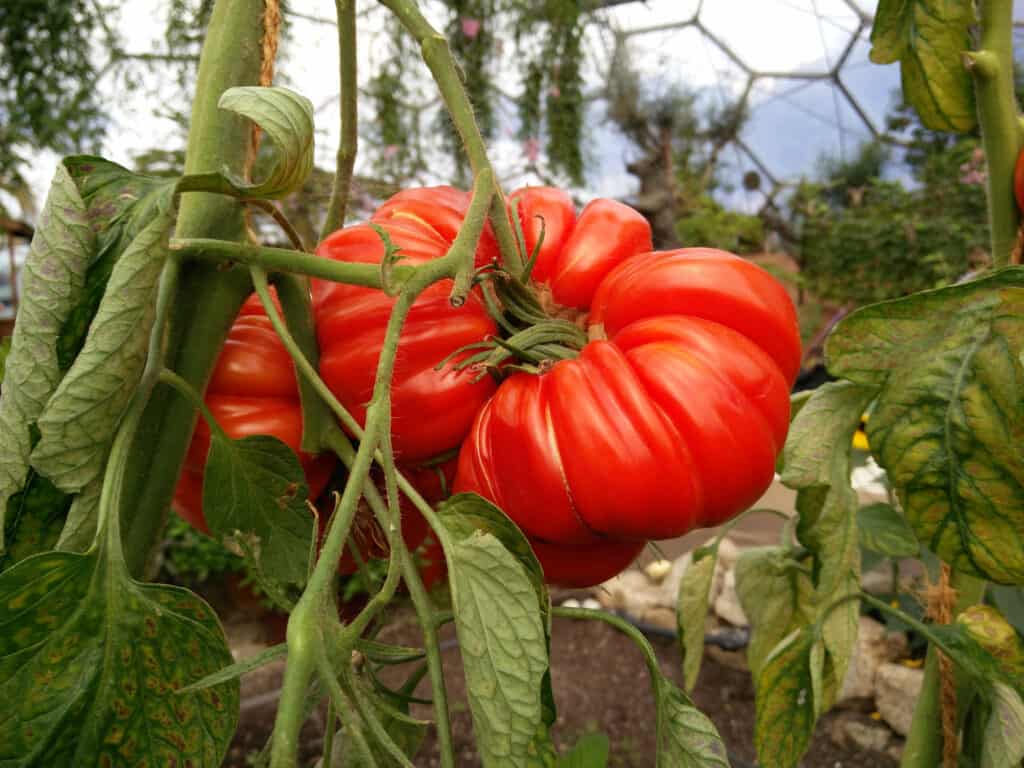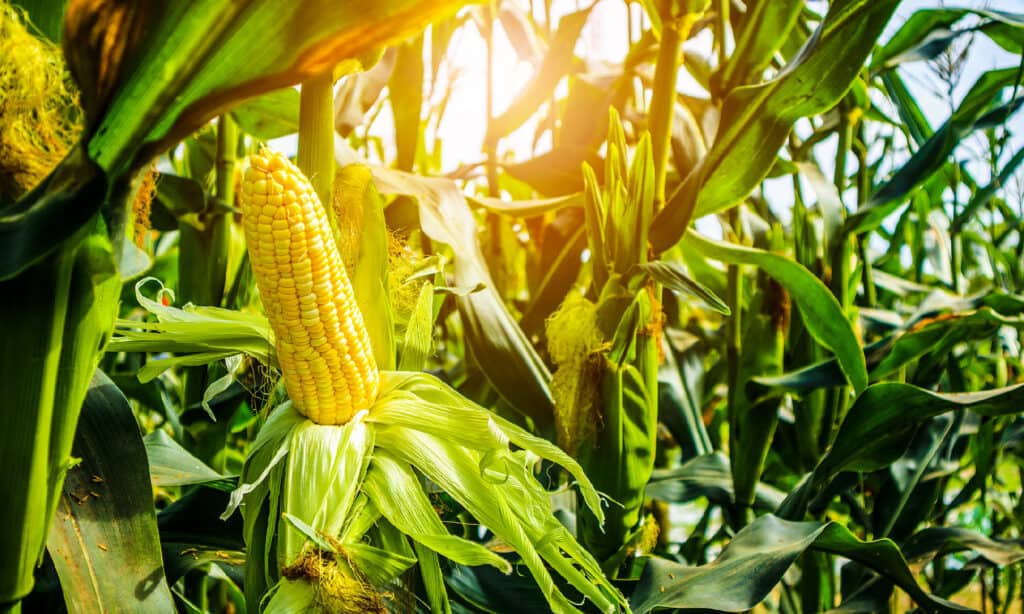If you love supersized fruit and veg, just wait until you hear about the longest corn cob ever grown. It reached such mammoth proportions that it rivaled a three-year-old child in length. Let’s discover the record, plus a few more epic-sized veggies, and how you can grow your own enormous corn cob.

The longest corncob ever grown reached 36.25 inches (92 cm) long!
©iStock.com/Qin PinLi
Official Longest Corn Cob Ever Grown
According to the Guinness World Records, Bernard Lavery of Llanharry, Rhondda Cynon Taff, Wales, U.K. holds the world record for the longest corn cob. His epic corn cob grew to 36.25 inches (92 cm) long. He grew his supersized corn in 1994, and no one has managed to beat it since.
There’s not much information about Mr Lavery because he grew the world’s longest corn cob before the internet really took off for the masses. Still, for comparison, an average corn cob reaches 7.5 to 8 inches long. That means the longest corn cob ever grown was 4.5 times the average size.
Most Corn Cobs on a Single Plant
Mr Lavery of the U.K. isn’t the only person to win a corn cob world record. In 2019, Matt Jacovelli of Deptford, U.S., broke the Guinness World Record for most corn cobs on a single plant. His single stalk produced a whopping 29 cobs! Rutgers agricultural agent Michelle Infante-Casella verified his productive corn on August 30.
But Mr Jacovelli can’t take credit for this abundant corn cob because squirrels planted it! A lover of squirrels, birds, and rabbits, he fed them Tractor Supply Producer’s Pride seeds, and the fairy tale-worthy corn cob appeared.
The previous record for most abundant corn cob only numbered 16, so Mr Jacovelli and his squirrel team smashed it.

The greatest number of corncobs on a single stalk is an unbelievable 29.
©iStock.com/zhengzaishuru
Where Are Corn Cobs Originally From?
9,000 years ago, the folks of Mesoamerica collected and planted a grass called teosinte. Over time, this wild grass morphed into what we know as maize, the common name for corn or sweetcorn.
It’s a really ancient foodstuff and one of the first plants humans cultivated. Ancient corn cobs were much smaller than today’s world record. Ancient cobs only reached a few inches in length, and they had hard casings.
World Record-Breaking Giant Fruit and Veg
The world’s longest corn cob grew to the length of a three-year-old, but what other world record-breaking fruit and veg collapsed the scales?
World’s Heaviest Tomato
Minnesota’s Del and Julie Faust grew the world’s heaviest tomato in October 2022. It weighed as much as a bowling ball at an eye-watering 11.65 pounds!

The world’s heaviest tomato topped the scales at 11.65 pounds.
©iStock.com/Sophie Shoults
World’s Heaviest Cucumber
David Thomas of the U.K. grew the Guinness World record-breaking cucumber. His gigantic cucumber weighed 23.7 pounds on September 26, 2015.
World’s Heaviest Chili Pepper
A chili pepper that weighed the same as a can of Pepsi? Yes! In 2022, Paul Davies of Halesowen, U.K., grew the world’s heaviest chili pepper, which clocked in at 16.22 ounces (460 grams)!
World’s Heaviest Pumpkin
This record changes hands frequently, but currently, Italy’s Stefano Cutrupi holds the world record for heaviest pumpkin. In September 2021, he produced 2,702 pounds and 13.9 ounces of super pumpkin. Not content with the heaviest pumpkin in the world, this supersized squash measured 11 feet and eight inches in width, which made it the largest pumpkin ever grown, too.
How to Grow Big Corn Cobs
In the world of competitive fruit and veg growing, secrets never leave the champion’s lips! However, experts recommend the following steps to grow a mega corn cob in your backyard.
Here’s how to grow long corn cobs.

Corn needs lots of sunlight, water, and proper pollination to grow large cobs.
©iStock.com/Kwangmoozaa
Seed Selection
Research indicates that the shape and size of a corn kernel do not dictate how large the cobs grow. It’s all about the genetics and environmental conditions.
However, research shows larger seeds have an advance initially because they contain more moisture. In drought conditions, a larger seed is likely to survive, whereas a small seed will dehydrate faster. However, given good growing conditions, size doesn’t make a difference; it’s all about good genetics.
So, first off, let’s crack the good genetics part with a reliable, healthy seed. The following regularly produce eight-inch long cobs:
- Lark F1 Hybrid
- Prelude
- Ambrosia Hybrid
- Honey Select Hybrid
- Jubilee Hybrid
- Ruby Queen Hybrid (a long red corn)
Before you commit the cash, consider the gigantic Choclo. It’s a Peruvian and Ecuadorian giant corn that dwarfs standard 13-foot tall cornstalks at 18 feet! The kernels are so large they’re eaten individually. However, this is a difficult crop to grow outside South America and it’s so tall that staking it is a problem.
And now, the best environment to grow long corn cobs in:
Growing Zones
Corn on the cob reliably grows in USDA hardiness zones 3-11.

Corn grows in USDA zones 3 to 11.
©Maksymowicz/iStock via Getty Images
Germinate Indoors
Corn germinates indoors on a warm windowsill so that cold zone growers can get an early start.
Frost puts corn growth back considerably, even killing it off completely, so it’s best to wait until all frost has passed over before committing to the soil.
Once the soil has warmed up in mid-spring, it’s time to plant out. Warm zone growers can pop seeds straight into the soil.
Best Soil for Huge Corn Cobs
Prepare your garden by digging it over to two spade depths (unless you’re a no-dig fan) and remove all the stones and weeds.
Sweetcorn struggles to grow on heavy, dry soil, so a generous application of well-rotted manure in early spring boosts their chances. Dig this in a month before planting out because manure can burn green veggies.
You can grow corncobs in a container, too. Make it as deep as possible, at least a few feet in height, to prevent toppling. Fill it with great-quality compost.

Corn grows best in nutrient-rich, loamy soil with lots of moisture retention.
©13Imagery/Shutterstock.com
Lots of Sun
Corn cobs thrive in warm, sunny sites, so a suntrap garden is going to encourage the longest cobs. Corn won’t ripen in the shade. Plant it in the sunniest spot you have or one that catches the morning sun. Experienced growers say at least 6-8 hours of sun produces the best corn cobs.
Spacing
Spacing is really important for corn because it’s wind-pollinated, not pollinated by bees and other beneficial insects. To pollinate and, therefore, produce corn cobs, plant corn in a square, not a line.
Block-planted corn pollen blows into its fellow corn stalks, but in a regimental line, it just blows away. Poorly pollinated sweetcorn results in patchy small cobs. It’s not what you want to rival a 36-inch long record-breaking corn cob.
Place each stalk around 18 inches apart so there’s room to grow.
How to Water Corn Cobs
To grow cornstalks with long cobs, extra water is needed, especially during dry spells. Corn uses a lot of water because it has a large leaf area. It needs water to swell up the cobs, too.
A profitable tip is sinking a six-to-eight-inch bottle (an orange squash bottle or similar) into the ground beside the roots. This helps water get straight to the roots instead of frying off in the sunshine.
Thorough Mulching
In order to trap moisture in the soil, use a layer of thick mulch.
Organic mulch is best because it seals in moisture, provides beneficial nutrients, deters snails, and suppresses nutrient-stealing weeds.
Place a two-inch thick layer of well-rotted organic matter, such as horse manure, around the roots in early spring, but avoid touching the stalk as this can lead to rot.
Three Sisters Companion Planting
Companion planting is a method whereby mutually beneficial plants are set beside one another. North American tribes developed one of the best systems. It’s called The Three Sisters. They planted sweetcorn, climbing beans, and squash together. If you’re after a world record-breaking corn cob, their approach might pay dividends.
- Sweetcorn – a pole for beans to climb up.
- Climbing beans – fix nitrogen into the soil to boost foliage growth.
- Squash – leafy squash foliage shades soil and increases humidity.

Squash is a member of The Three Sisters companion planting set.
©Juli V/Shutterstock.com
Corn Cobs Are Dangerous for Dogs
Tasty corn cobs are a BBQ treat that we love, but the indigestible inner core is dangerous for dogs. It’s not toxic, but dogs can’t digest it, and this leads to expensive and sometimes fatal gut blockages. Be sure to dispose of corn cobs safely during your BBQ so Rover doesn’t run off with a cob to choke on.
The Longest Corn Cob Ever Grown
So, we’ve discovered that the longest corn cob ever grown set seed in Wales, UK. The cob grew to a mind-boggling three feet, or 36.25 inches, to be exact. Bernard Lavery ripened his record-breaker all the way back in 1994.
The photo featured at the top of this post is © Photoongraphy/Shutterstock.com
Thank you for reading! Have some feedback for us? Contact the AZ Animals editorial team.






